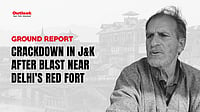Symptoms Linked To Early And Middle Stage Dementia
- Forgetfulness
- Losing track of time
- Getting lost in familiar places
- Difficulty in communication
- Behavioural changes
(Source: World Health Organisation)
***
What would it mean to be at the peak of your abilities, to have a busy job and hectic schedules, and then to be suddenly robbed of the very faculties that shaped your life? All around us there are many tragic stories of snatched memories among the elderly—and, though rarer still, among the middle-aged too. Some of that plays out in many ways, at many places, and those who suffer, often do so silently. Not long ago, outside one of Bangalore’s government offices, an officer arrived in a car and wanted to be let in. There was some confusion because the officer didn’t work there anymore, but, tragically, the person had forgotten that. In the mid-40s, the officer had been diagnosed with early-onset dementia some months earlier.
For the majority of people affected by dementia, whether it’s due to Alzheimer’s or some other syndrome, the devastating condition sets in mostly after the age of 65. “But we do come across people in their 50s and early 60s developing dementia,” says Dr Jacob Roy K., who founded the Alzheimer’s and Related Disorders Society of India (ARDSI) in 1992 after his experience of caring for his father at a time when dementia was hardly acknowledged as a problem that affected people in India.
Dementia affects around 50 million people worldwide and there are nearly 10 million new cases every year, according to the World Health Organisation (WHO). Though it mostly affects older people, it is not a normal part of aging. The most common form is caused by Alzheimer’s. After China and the US, India has the world’s third largest number of people with dementia: over four million.
"Not even 10 percent of those estimated to be affected are diagnosed. That's no surprise as many think it is a part of ageing or a purely psychiatric problem, or that nothing much can be done," says Roy.
“That’s just the number of those diagnosed with dementia—not even 10 per cent of those estimated to be affected. That’s no surprise as many think it is a part of ageing or a purely psychiatric problem, or that nothing much can be done,” says Roy, adding that our understanding of the condition has definitely got better in many ways, and so have the diagnostic tools. “More and more people are bringing in their relatives with cognitive decline and behavioural problems,” he says.
As far as a cure is concerned, however, Roy believes things haven’t changed much in the two-and-a-half decades since he started ARDSI. “It is so not just in India, but globally too,” he says. “That’s because we are still far away from a cure, and the currently available medications are mostly symptom modifiers.” The biological causes of dementia, which leads to a devastating loss of memory and decline of brain functioning, are still a mystery.
Wendy Mitchell, 61, whose book Somebody I Used to Know was released this month, was a non-clinical team leader with the National Health Service at Yorkshire in the UK, managing rosters for hundreds of nurses. She was in the middle of her annual vacation and out on a run. It was a way to get away from a strange fuzziness that she had been feeling for some time. Then, a fall. Luckily, no serious injury. But a few months later, another one. For Mitchell, then 58, a workaholic, that feeling of life being a little less sharp was the start of a series of medical checks that led to a painful diagnosis. Young-onset dementia.
That was in 2014. She began writing a blog to allow her “to write all my thoughts before they’re lost”. She has calendars to take care of the future, writes Mitchell. “But this blog serves as a reminder of what I’ve done and said in the past—it now serves as my memory.”
The global search for drugs to treat such diseases has been difficult—experts say most attempts over the past decade-and-a-half have failed. One of the keenly watched drug candidates now in late stage trials is Aducanumab—an antibody that targets amyloid plaques in the brain—which is being developed by the US firm Biogen Inc. The accumulation of amyloid, a protein, in the brain is linked to Alzheimer’s.
Last month, American pharma firm Pfizer announced its decision to end drug discovery in neuroscience—news received by many as disappointing for research into Alzheimer’s and Parkinson’s diseases. “Pfizer scientists have worked for decades to advance potential therapies for these devastating diseases. However, after our internal programmes faced continual setbacks, we had to come to terms with the fact that our research efforts were simply not making the progress necessary to translate into truly transformational therapies for patients,” the firm said in a statement. It now plans to create a venture fund, which would invest in biotech companies conducting promising neuroscience research.
According to Prof Vijayalakshmi Ravindranath from the Centre for Neuroscience at Bangalore’s Indian Institute of Science (IISc), much of the current thinking is about how we could diagnose dementia earlier and would we be able to intervene, at least through non-pharamocological means? “Hopefully, whenever a drug comes, we should be able to intervene earlier. But, at least, we can start intervening because we know all the cardiovascular risks—diabetes, hypertension, obesity, smoking etc—are risk factors for dementia too, while exercise is a very positive factor,” she says.
This month, Ravindranath’s lab reported a new finding in the search for a biomarker, or an early indicator of the disease. Long-term research studies show that the amyloid build-up starts happening 20-30 years before the onset of clinical symptoms. The lab studied the role of filamentous actin (F-actin), a protein that shapes the spines on dendrites, the threadlike contact points on a neuron that receive inputs. A neuron makes contact with another neuron through synapses, or junctions located at their tips. When the structure of F-actin was affected, the spines disappeared. “So that meant there was no cross-talk happening,” says Smitha Karunakaran, who has co-authored scientific articles with Ravindranath and Reddy P. Kommaddi.
“We found that the synaptic dysfunction—a dysfunction of the points that actually signal in the brain—starts in animals as early as one month of age, whereas the symptoms of dementia are normally visible only at about eight to nine months,” says Ravindranath. The team conducted a Pavlovian fear-conditioning test on genetically-modified mice, which showed the animals weren’t making associations and forming memory. But when the F-actin was stabilised using a drug, their behaviour reversed and the mice started to remember an experience.
Once they found that F-actin played a role in loss of memory in animals with Alzheimer’s, the team collaborated with the Rush Alzheimer’s Disease Center in Chicago to procure post-mortem samples from human subjects. “We looked at the status of actin in them and, sure enough, we found what we saw in the animals replicated in the human body,” says Ravindranath. “This was quite surprising because until then the structural component of the synapse had never been associated with the disease—we always thought the structural component was there only to give the shape and that they may not actually participate in the disease process itself.” The team is planning further research into the possible role of F-actin as a biomarker.
Data on dementia in India, researchers point out, has generally been insufficient. The risk factors differ from population to population—socio-economic background and literacy levels are contributing factors. Therefore, studies of aging populations done elsewhere may have their limitations.
“It was during the decade from 2000 to 2010 that research in the field of dementia was beginning to emerge in the country,” says Dr P.S. Mathuranath of the National Institute of Mental Health and Neurosciences (NIMHANS) in Bangalore. In 2012, Mathuranath had reported incidence rates of Alzheimer’s in Thiruvananthapuram after a study of 2,466 elderly people over a period of 10 years.
According to Dr Vijay Chandra, who recently published a paper on the common occurrence of Lewy body dementia (LBD)—it’s milder and progresses slowly, but could cause hallucinations—“the focus has now turned to all dementias, primarily because it is a public health problem”. “The tragedy is these hallucinations are considered a psychiatric problem and they are given all kinds of antipsychotics, which can be harmful to them,” says Chandra. “There isn’t much awareness about this condition in the general population.”
Over the past couple of months, researchers at the Centre for Brain Research (CBR) at IISc, Bangalore, have embarked on a new study at Srinivasapura, around 90 km northeast of Bangalore, to track at least 10,000 middle-aged people as they grow old—and until they die.
“Brain structure is the hallmark because cognitive function can be subjective. But the brain doesn’t work in isolation...it also needs the environment,” says Dr Ganesh Chauhan, a scientist at CBR. The CBR team wants to tease out information of all sorts—social, economic, physical, psychiatric—and do various tests such as brain MRI, ECG, ultrasound of the abdomen, eye scans etc, besides collecting background information like the geography of the region and the various kinds of pollution people are exposed to. “People show the symptoms of dementia when they are around 60-65. That is where our study becomes a little more useful as we start studying people from the age of 45,” says Chauhan.
“Dementia needs to be recognised as a health priority because of its enormous impact on the affected person as well as the family,” says Roy of ARDSI, which runs day-care centres in many cities and towns across India. “Most of the affected people are suffering in silence. They don’t know where to go for help, or what to do with the patient. That is a sad state of affairs. It has to change.” A lot more can be done in terms of taking care of the personal needs of affected people, seeing that accidents are prevented and their legal and financial issues taken care of.
“The key message that should go to any patient diagnosed with dementia is that it is not the end of the road. It’s not a death sentence,” says Roy. “You have to go from a bleak scenario to a more positive outlook...no medicine, no magic. But you can still live well with dementia.”
By Ajay Sukumaran in Bangalore


























